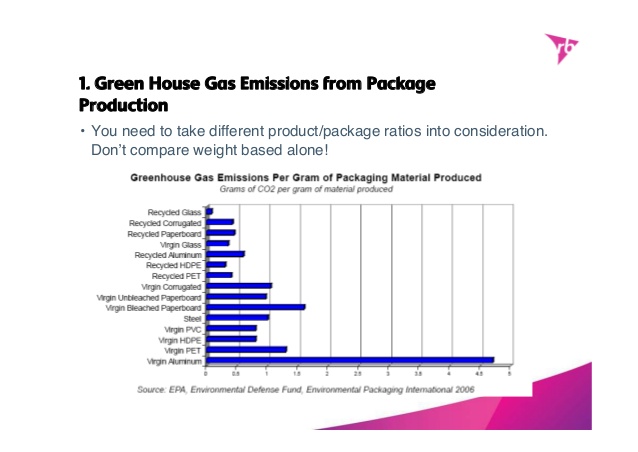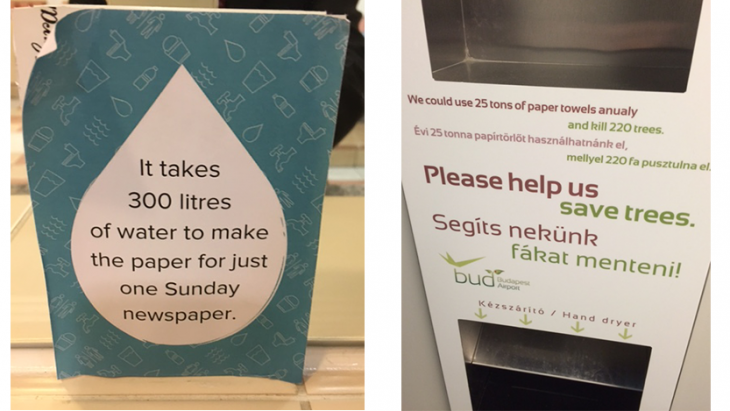
The Full Picture
When it comes to Greenwashing, customers are often only getting a small part of the picture. For some products, it's clear that the packaging tells a completely different story from that of the contents, especially with chemical products with 'eco-friendly' labels. But for others, companies are quick to point out the seemingly earth-conscious nature of their solution while avoiding the full picture. For example, based on the data below, you might assume that glass is the most environmentally-friendly packaging material. And, companies may bank on this and advertise this as a clean-cut fact, but the truth is that there is much more to the whole process that isn't fully captured in most graphs and data collection.

What they may neglect to mention however, is that the life cycle of glass materials can be much farther from the given figures if you account for the much greater fuel used to transport glass (since it is much heavier than other materials), and that while glass is quite easy to recycle, it remains difficult to separate clear glass from other colors. This can result in a much greater quantity of brown recycled glass compared with other colors, a color with a lower demand compared with others. Nonetheless, glass is a highly-recyclable product with great qualities.
The point here is that it's easy to, in the world of marketing for sustainability, claim superiority if only a fraction of the data is used. Take products like ebooks for example. On paper (pun intended), ebooks are the clearly more eco-friendly than paper books, right? Well maybe not. Think about the power you use every time you want to read that ebook. Think about the emissions produced and rare earth metals harvested during the creation of your electronic ebook reader. In the end, it's up to you, as both a consumer and as a business owner, to think critically about the message and make sure it's accurate. For some marketing examples that don't quite get it right, read the article below.
Don’t believe all you read!
How often have you seen a marketing message that just doesn’t seem right but you’re not sure what the truth is? Kindly, two eagle-eyed Two Sides members reached for their cameras and have asked us to investigate some recent scare messages.

Case 1: “It takes 300 litres of water to make the paper for just one Sunday newspaper”
For this, I consulted my knowledgeable colleagues John Sanderson and Päivi Rissanen of leading paper producer UPM.
The figures that paper mills quote for ‘water consumption’ (for instance on a Paper Profile) is their physical use of water. It’s usually the mills’ metered water use or effluent discharge divided by the paper production to give m3/t. Simple as that.
In the case of UPM’s Nordland paper mill, the water use is 3.5 m3, (3,500 litres), per tonne. The UPM Nordland Mill is regarded as being amongst the ‘best in class’, however all European mills are expected to meet what are called BAT AEPL levels (environmental performance levels achieved through the use of best available techniques). A typical newsprint mill using recycled fibre would be expected to have water consumption no more than 8 – 15 m3, (8,000 – 15,000 litres), per tonne.
So, using the lower figure, what would be the consumption for some common uses of paper?

So, again, 300 litres for a newspaper is just plain wrong! Somewhere between 2 litres, best in class, and 10 litres, worst in class, is the case.
Please also remember:
- Paper is normally made in areas with plentiful water
- Water, locked up in paper (about 5%) is released when recycled or composted
- Water lost as steam during manufacture eventually returns as rain
For a detailed report on water use in paper manufacture, click here
Case 2: “We could use 25 tons of paper towels annually and kill 220 trees”
Seems a lot doesn’t it?
I asked our friend Roberto Berardi, Chairman, European Tissue Symposium, to let us know the facts.
The Western Europe consumption of Paper Towels is as follows:
- Consumer Towels: about 1,050,000 tonnes / year
- AFH, (Away from Home), Towels: about 800,000 tonnes / year
The Towels portrayed in the image are AFH Towels.
The population of Western Europe for the same countries as the above consumption data is about 410 million.
Therefore, the annual per capita consumption of AFH Towels is 800,000 tonnes/year. For 410 million people this is 1.95 KG per capita. (All paper towels, including those used in the home, would be 4.51 Kg per capita)
It may be useful to add that the total yearly Consumption of Tissue products, including Toilet Tissue, Towels, Napkins, Facial/Hanks, including at Home and Away From Home, is about 15.5 KG per capita, ranging from 20 Kg per capita in Sweden, to 12 Kg per capita in Malta.
So, whatever figure you use 25 tonnes of towels, as quoted in the picture, is both meaningless and misleading.







